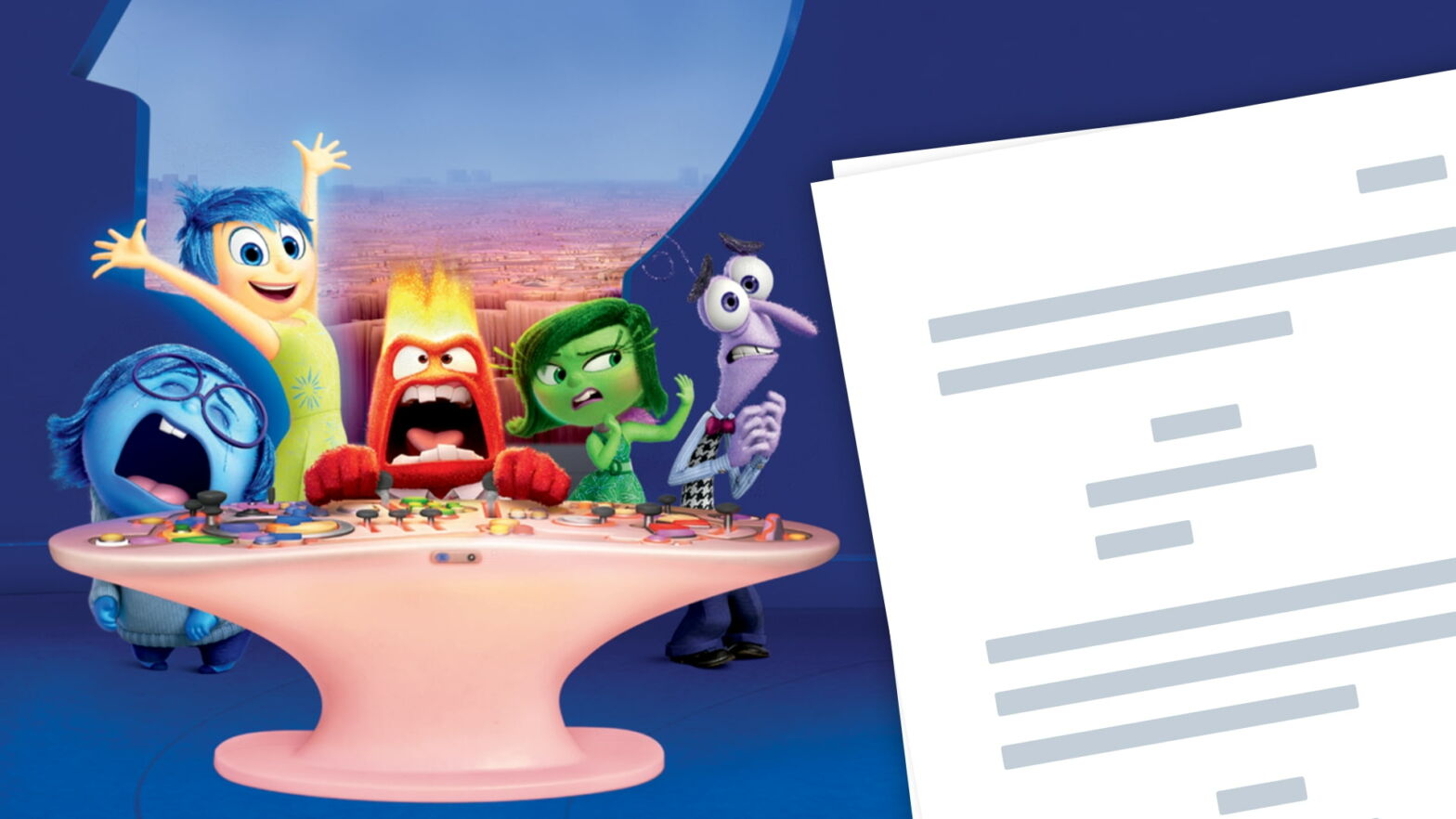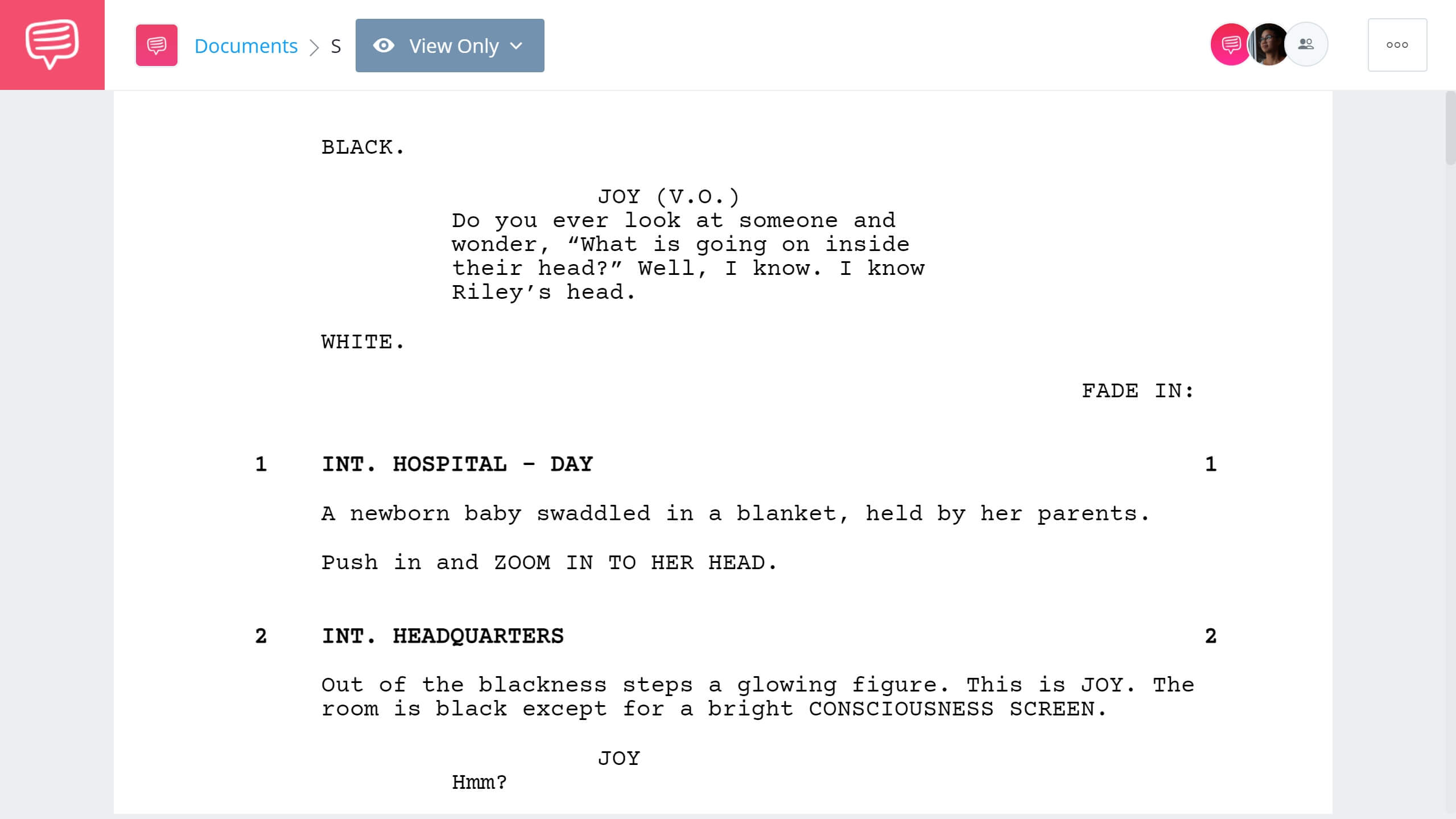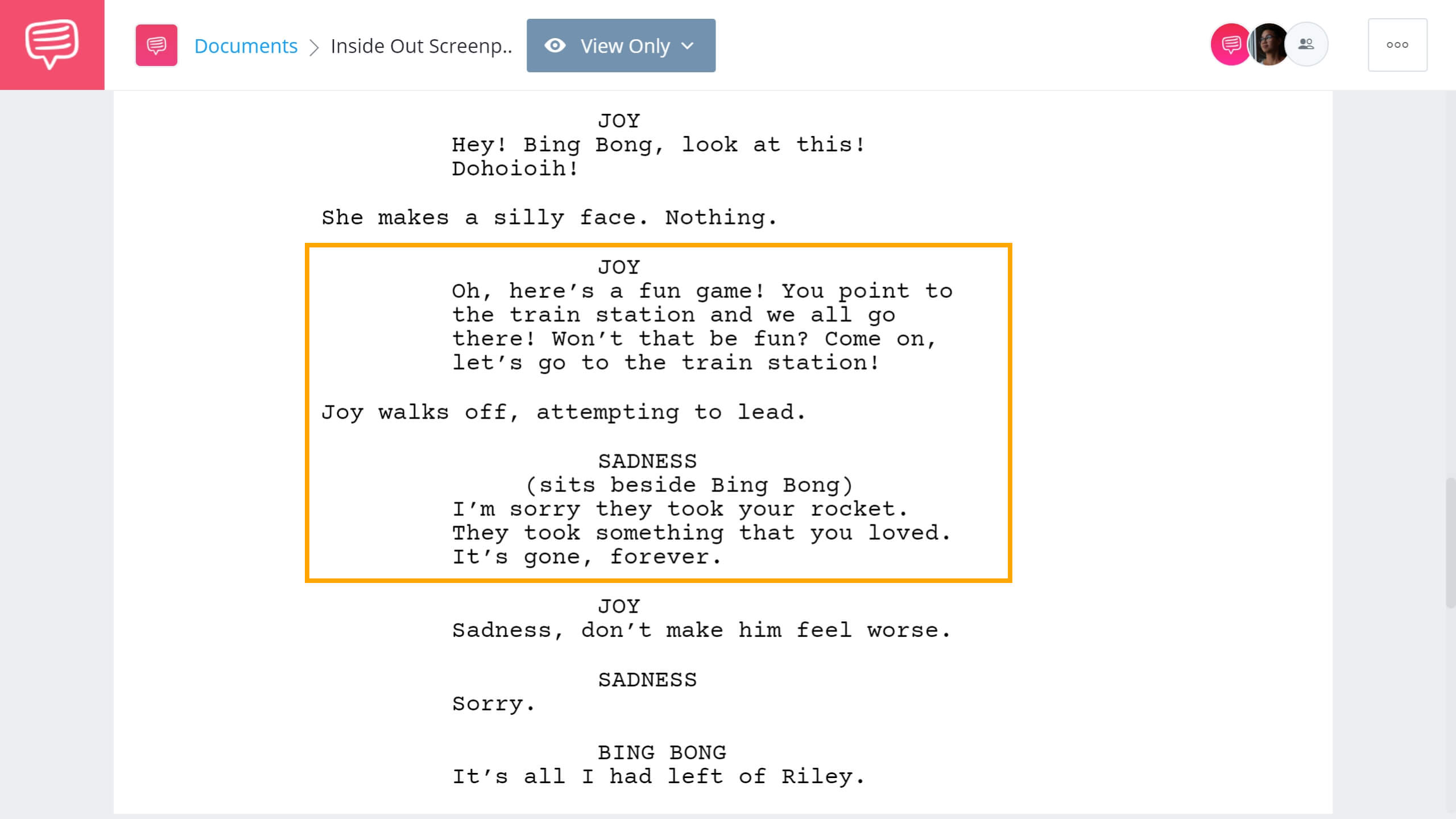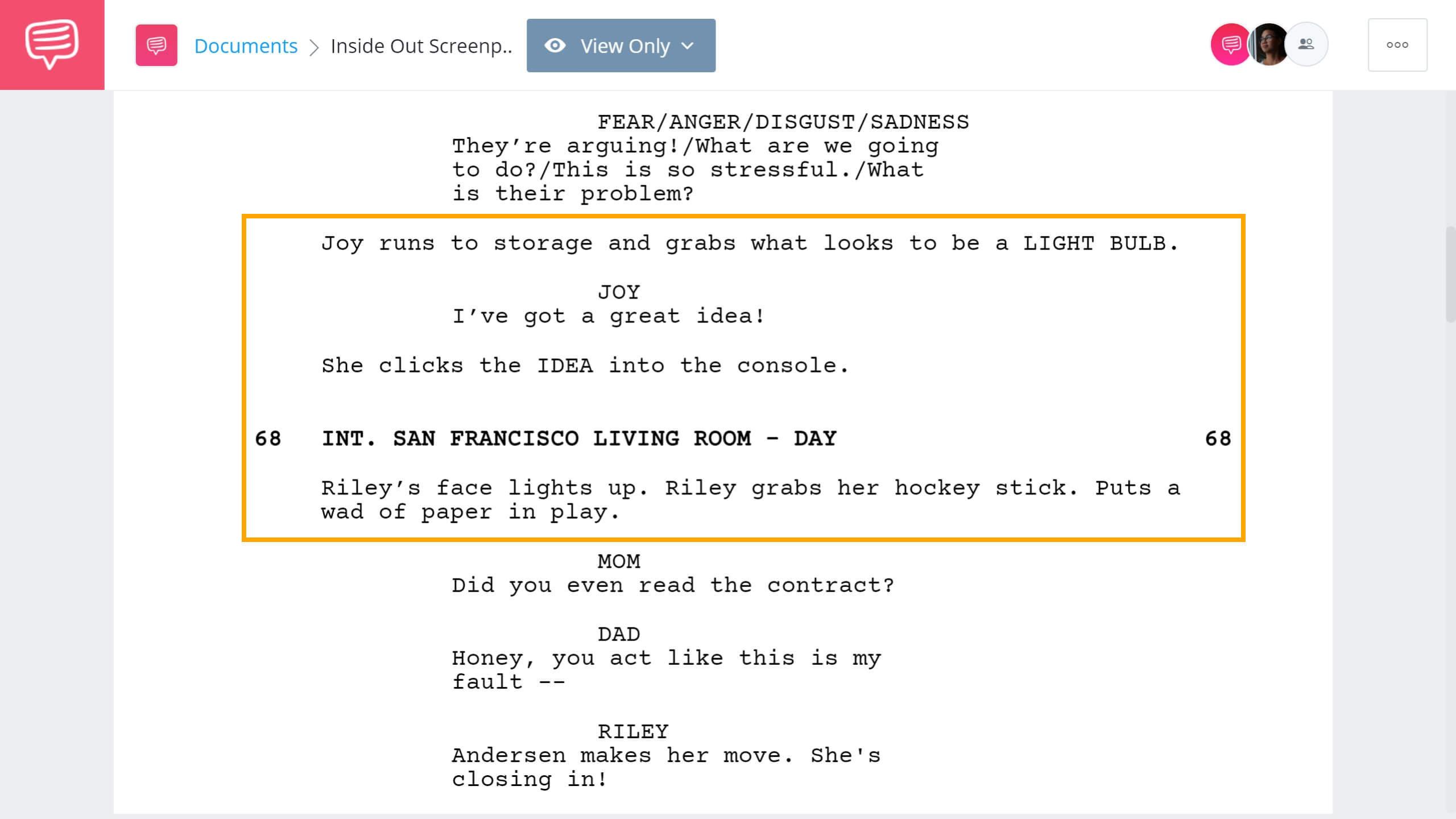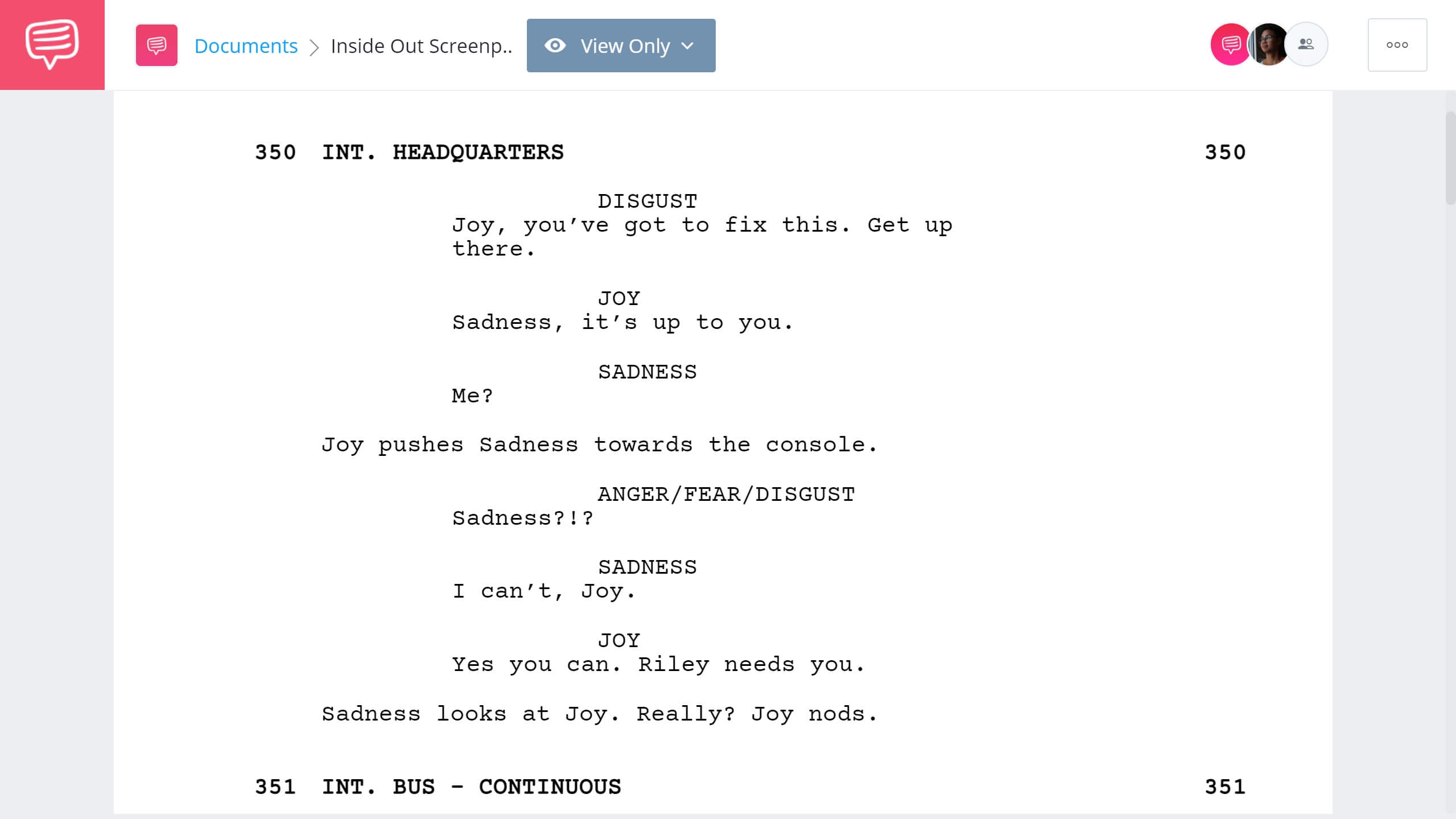Pixar has always found a way to tell stories that appeal not only to children, but to audiences of all ages. The Inside Out script proves to be no different. The complex concepts of emotional intelligence are simplified, but not compromised in this entertaining tale of a girl coming to terms with the changes in her life and how her emotions help her get there. Creating this story, however, was not a simple process. Let’s take a look at how the folks over at Pixar constructed Inside Out on the page.




WHO WROTE inside out?
Original story by...
Ronnie Del Carmen is an award winning animation writer, story artist, story supervisor and production designer as well as the co-director of Inside Out.
Pete Docter is also the co-director of Inside Out and the Chief Creative Officer at Pixar. Docter is best known for producing and writing major Pixar films such as Up and Monsters, Inc.
Screenplay by...
Pete Docter is also a co-writer of the Inside Out script.
Josh Cooley is an animator and screenwriter who also wrote the Pixar spin off short film Riley's First Date? He went on to direct Toy Story 4.
Meg LeFauve is a screenwriter and producer who, in an interview said this about Docter’s conception of the film’s idea:
“The director, he had a daughter. And she was so happy all the time, and she was so joyful. And then she turned eleven. And suddenly she was quiet and she wasn’t smiling... and he sat at breakfast and he wondered, ‘What happened to joy?’ And then he thought: I’m going to make a movie about that.”
Inside Out summary
Inside Out SUMMARY AND SCREENPLAY
Here is the story structure for Inside Out screenplay:
Exposition
Riley’s memories are created through her emotions: Joy, Fear, Anger, Disgust, and Sadness. Riley’s personality is made of islands: Family, Friends, Hockey, Goofball, and Honesty.
Inciting Incident
When Riley’s family moves to San Francisco, Riley is disappointed. While introducing herself to her class, Riley recalls a memory of her old home that turns from joyful to sad. Riley cries and her first sad core memory is created.
Plot Point One
Sadness touches a core memory. In a struggle, Joy and Sadness knock over all core memories and are sucked out of the command center. Meanwhile, Riley acts out without Joy or Sadness.
Rising Action
To return to the command center, Joy and Sadness follow Bing Bong, Riley’s old imaginary friend, through Riley’s mind. Bing Bong leads them to the Train of Thought which would return them to the command center, but they miss the train.
Midpoint
Bing Bong is disheartened after seeing his wagon fall into the Memory Dump of Riley's subconscious. Joy realizes Sadness’ true value when she comforts Bing Bong. The three board the Train of Thought and head toward the command center.
Plot Point Two
While trying to wake Riley up to start the train, Bing Bong and the core memories are lost to the prison of the subconscious. Joy and Sadness rescue them by using a clown they found to trigger a nightmare and start up the Train of Thought.
Build Up
Without Joy, Sadness, or her core memories, Riley decides to run away. While getting sucked back to the command center, Joy restricts Sadness from coming. The tube Joy travels through breaks. Joy and Bing Bong fall in the Memory Dump.
Climax
Bing Bong sacrifices himself in order to get Joy out of the Memory Dump. Joy and Sadness rush back to the command center just in time to restore the core memories and prevent Riley from leaving. Riley breaks down to her parents and a new hybrid core memory of sadness and joy is created.
Finale
A new dashboard is installed in the command center that allows all of Riley’s emotions to work together. Riley joins the hockey team as her parents cheer her on from the stands.
Inside Out Script Takeaway #1
Inside Out quotes use perspective
One aspect that makes Pixar movie screenplays like the Up screenplay and the Coco script is the use of point of view. Inside Out functions by putting the audience in Joy’s perspective. The audience shares the character arc that Joy undergoes. Throughout the movie, Joy struggles with Sadness, but comes to see her true value and embrace her at the end of the film. The first time we and Joy realize this is in this scene below.
We added the Inside Out script to the StudioBinder screenwriting software so we could analyze specific Inside Out quotes. In this scene, Bing Bong’s wagon falls into the Memory Dump and Joy and Sadness handle the situation two different ways.
Sadness comforts Bing Bong • Read the Entire Scene
Joy always tries to find ways to bring fun and positivity to a bad situation. However, when she tries to do this with Bing Bong it doesn’t work. Sadness’ approach of sympathizing with Bing Bong does work. For this realization to occur in both us and Joy, the writers had to put us in Joy’s point of view throughout the film. How do they do this?
Firstly, they had to make Joy a likable and relatable protagonist. This meant that Joy had to be both vulnerable and overcome obstacles. Secondly, the writers made Sadness as annoying as possible so that the audience can understand Joy’s frustration with her. Lessons from the Screenplay breaks this down in their video essay on the creation of Inside Out.
Inside Out Quotes • Creating the Story
In writing the screenplay for Inside Out, the writers discovered the importance of point of view. By coming to his own realization that embracing sadness is the key to healthy relationships, Docter, LeFauve, and Cooley understood the importance of establishing Joy’s perspective to have the audience experience this same epiphany.
Related Posts
Inside Out Script Takeaway #2
Inside Out characters defined by action
As a children’s movie, Inside Out uses simple, little moments to establish characters. This is both efficiency and engaging storytelling. Rather than using long speeches, Inside Out characters are revealed through action.
In this simple four-page scene, both Joy and Riley find a way to stay positive in a bad situation. Yet, despite their attempts, the scene still ends sadly. In this situation, the writers define traits of every single character through their simple actions.
The New House • Read the Entire Scene
In this simple four page scene, what were the writers able to communicate? Let’s start with what occurs inside Riley’s brain. The most obvious reactions came from all of Riley’s emotions. The scene establishes how each emotion reacts to a situation.
Most importantly how Joy tries to fix sad situations with more joy. The end of the scene in which Joy almost doesn’t have a solution also reveals her vulnerability and aversion to Sadness.
Outside of Riley’s brain, we learn how Riley, through Joy’s actions, also spins these situations positively. She does it initially with hockey and then again with pizza. This shows her suppression of sad emotions.
The scene even establishes the minor Inside Out characters. Riley’s dad loves her but is also a workaholic. Her mother is a supportive wife and mom that is having her issues with the move.
On screen, the scene establishes character relationships efficiently in just under two minutes. Let’s see how this scene translates from script to screen.
Inside Out Characters • New House
By using small moments like this, the Inside Out script establishes characters simply, efficiently, and effectively. Using action to reveal character keeps a scene moving and engaging that ultimately leads to a better film.
Inside Out Script Takeaway #3
Inside Out ends thematically
Pixar is a master at theme. Co-writer and director Pete Docter understands the importance of a film’s theme being at the heart of it’s narrative. So, what is the theme of Inside Out?
Through Joy, Riley, and even Docter’s own experience, we realize that the key to healthy relationships is to embrace sadness. This theme is fully realized at the end of the film when Joy hands Sadness the core memories to restore and Riley breaks down to her parents. Click the image to read the entire, emotionally-charged ending.
Inside Out ending • Read the Entire Scene
Throughout the film, Joy’s “want” of making Riley happy is what drives the plot forward. However, this is fully realized when Joy gets her “need.” Joy needed to embrace sadness. In doing so she also gets her “want.”
By tying in the film’s theme to the plot and character arcs, the ending of the film becomes a cathartic moment for the characters and audience.
Inside Out plot • Ending Scene
The ending of Inside Out underscores the importance of theme in film. To have a satisfying and cathartic ending to a film, the theme must be distinct and clear so that it can be fully realized.
Inside Out executes the difficult task of simplifying a sophisticated concept through effective storytelling. It is difficult to categorize the film as solely a kid’s movie due to its relevance to every member of any audience.
Pixar and Pete Docter hit yet another home run that will last for years to come with Inside Out.
UP NEXT
Read and download more scripts
Inside Out is just one of many movies that prove Pixar’s masterful grasp on storytelling. If you want to continue reading screenplays, we have similar titles like Frozen, Up, and Ratatouille in our screenplay database. Browse and download PDFs for all of our scripts as you read, write and practice your craft to become the next great screenwriter.
